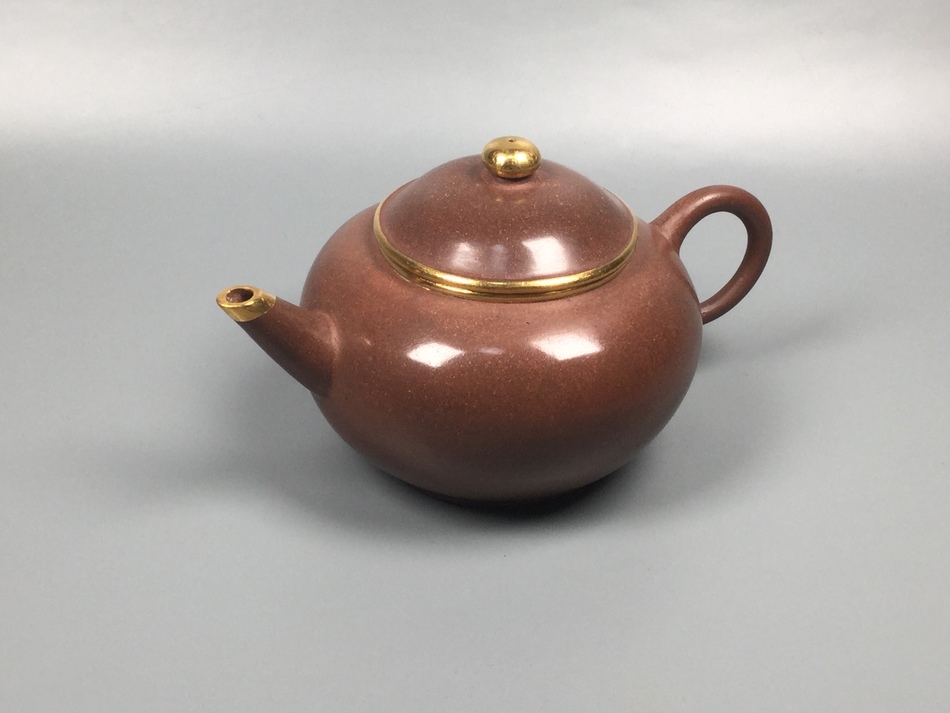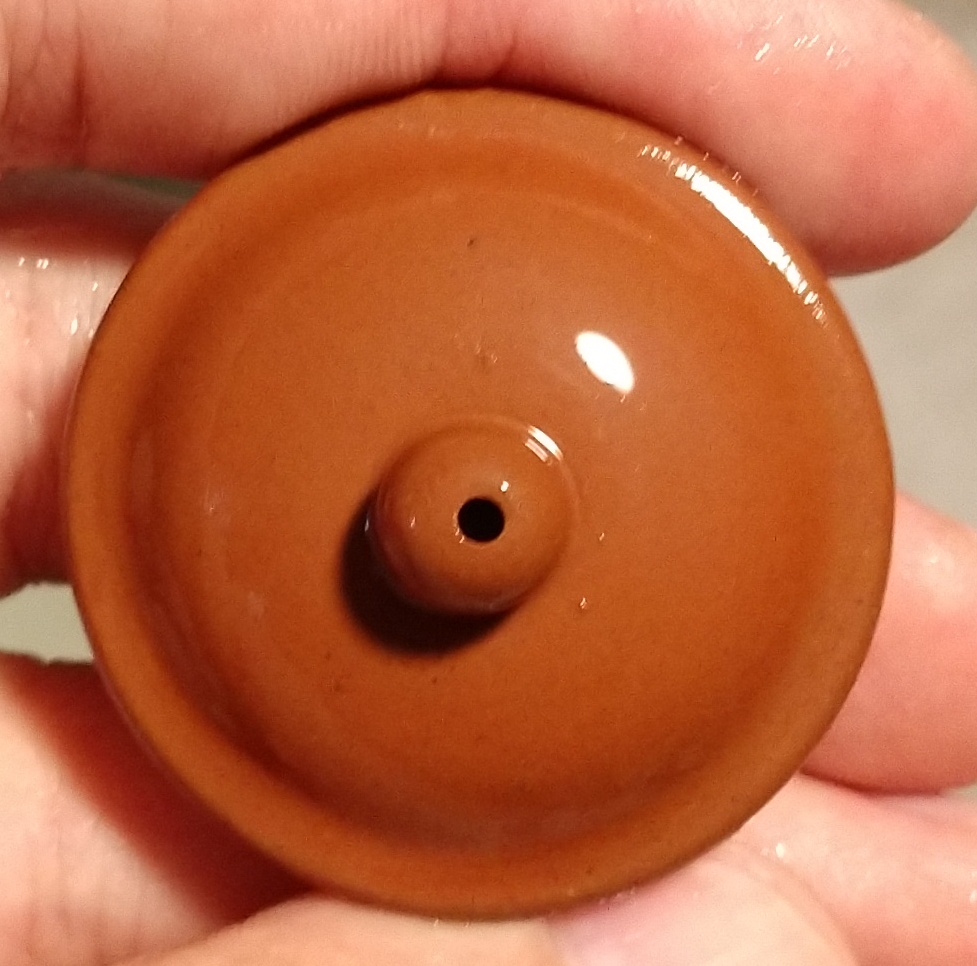Makes perfect sense, thank you for the sound insight. In my case, I am not purchasing for liquidity purposes, I just considered it a potential perk. I fully intend to use, and care for these items. The few antique teapots I have purchased are at least coming from an individual who does have a strong reputation. I will definitely be keeping all documentation.steanze wrote: ↑Sun May 24, 2020 2:12 pmI don't remember 17th century from K. S. Lo's book... that book contains some inaccuracies, for example it swapped the names of Cheng Shouzhen's son and grandsonTeaTotaling wrote: ↑Sun May 24, 2020 12:50 pm
I recently read and excerpt from Kuei-hsiang Lo’s book, and it’s believed many Gongju pots were made during this time. Not to say the style didn’t continue on afterwards.
You are thinking, say a 60’s pot, might be a better investment than a Qing pot of impeccable quality?
I think neither is a good investment, because a good investment needs to have liquidity. If you need to liquidate a teapot as a private buyer and you don't have a strong reputation as expert it will not be easy to turn it into cash quickly without a loss.
Yixing
- TeaTotaling
- Posts: 521
- Joined: Sat Apr 25, 2020 3:08 pm
- Location: Ohio
Yes, that makes sense - they should keep some value if well cared for. It is important to be aware that they are not a substitute for investments.TeaTotaling wrote: ↑Sun May 24, 2020 2:37 pm
Makes perfect sense, thank you for the sound insight. In my case, I am not purchasing for liquidity purposes, I just considered it a potential perk. I fully intend to use, and care for these items. The few antique teapots I have purchased are at least coming from an individual who does have a strong reputation. I will definitely be keeping all documentation.
I think 17th century sounds indeed a bit early for this style... even if something of that name existed back then, I doubt it would look similar to the Gongju shapes we are familiar with. The few Ming dynasty Yixing I have seen, look a LOT different to what came afterwards.TeaTotaling wrote: ↑Sun May 24, 2020 10:32 amthe Gongju style of teapot, made between the early years of the 17 century, and on into the middle of the 18th century.
You are right that the book mentions a couple of examples allegedly from the 17th century. That is very early for Gong Ju pots however, most of them are from much later.TeaTotaling wrote: ↑Sun May 24, 2020 12:50 pm
I recently read and excerpt from Kuei-hsiang Lo’s book, and it’s believed many Gongju pots were made during this time. Not to say the style didn’t continue on afterwards.
You are thinking, say a 60’s pot, might be a better investment than a Qing pot of impeccable quality?
@TeaTotalingTeaTotaling wrote: ↑Sun May 24, 2020 10:32 amI have long admired the Gongju style of teapot, made between the early years of the 17 century, and on into the middle of the 18th century. I also appreciate the timeless elegance of teapots inlayed with gold, such beautiful works of art, in my opinion.
17th Century , 18th Century GongJu??.....
Cheers!
- TeaTotaling
- Posts: 521
- Joined: Sat Apr 25, 2020 3:08 pm
- Location: Ohio
Thank you for the wise clarification @Bok & @steanze, you both are a great help.
@OCTO Thank you for the helpful insight as well. From what I can tell from the 360° view of these teapots, the inlaying doesn't appear to be covering any defects. Although pictures can be deceiving. I will definitely be questioning this, thanks to your help!
@OCTO Thank you for the helpful insight as well. From what I can tell from the 360° view of these teapots, the inlaying doesn't appear to be covering any defects. Although pictures can be deceiving. I will definitely be questioning this, thanks to your help!
- Attachments
-
- IMG_0528.jpg (144.69 KiB) Viewed 9818 times
-
- IMG_0554.jpg (151.33 KiB) Viewed 9818 times
Welcome! It is possible that the spout tip and the rim were chipped, and that the gold was added as a repair. That kind of gold inlay is not usually original to the pot.TeaTotaling wrote: ↑Mon May 25, 2020 10:06 amThank you for the wise clarification Bok & steanze, you both are a great help.
OCTO Thank you for the helpful insight as well. From what I can tell from the 360° view of these teapots, the inlaying doesn't appear to be covering any defects. Although pictures can be deceiving. I will definitely be questioning this, thanks to your help!

- TeaTotaling
- Posts: 521
- Joined: Sat Apr 25, 2020 3:08 pm
- Location: Ohio
@steanze I will definitely be doing further research. Both of these pots are in excellent condition from what I can tell. The seller has been very transparent, answering all of my questions, and granting my requests.
Do you have any knowledge/insight on the workshop Chang Kee?
Do you have any knowledge/insight on the workshop Chang Kee?
I don't mean to say that the seller is misleading. Did they ever imply that the gold accents were part of the pot since it was originally made? If not, it would be totally fine to add some gold accents for repair and sell a pot.TeaTotaling wrote: ↑Mon May 25, 2020 10:25 amsteanze I will definitely be doing further research. Both of these pots are in excellent condition from what I can tell. The seller has been very transparent, answering all of my questions, and granting my requests.
Do you have any knowledge/insight on the workshop Chang Kee?
I don't know that workshop, if you send the name in Chinese characters I might be able to find out more. Maybe you mean 昌記? If that's what you mean, yes, I am familiar with the workshop. It is well known for producing finely crafted zhuni teapots in Late Qing and ROC.
There are piles of fake 昌記 pots around, so be careful. ZAG is a reliable source, so you should be fine there...
- TeaTotaling
- Posts: 521
- Joined: Sat Apr 25, 2020 3:08 pm
- Location: Ohio
Understood. My philosophy has always been to question everything, and you have given me more questions to ask, that I didn't initially ask. Very helpful. I am waiting on a reply to this question regarding the gold inlays.steanze wrote: ↑Mon May 25, 2020 11:27 amI don't mean to say that the seller is misleading. Did they ever imply that the gold accents were part of the pot since it was originally made? If not, it would be totally fine to add some gold accents for repair and sell a pot.TeaTotaling wrote: ↑Mon May 25, 2020 10:25 amsteanze I will definitely be doing further research. Both of these pots are in excellent condition from what I can tell. The seller has been very transparent, answering all of my questions, and granting my requests.
Do you have any knowledge/insight on the workshop Chang Kee?
I don't know that workshop, if you send the name in Chinese characters I might be able to find out more. Maybe you mean 昌記? If that's what you mean, yes, I am familiar with the workshop. It is well known for producing finely crafted zhuni teapots in Late Qing and ROC.
Characters are as follows...昌記
@OCTO
Have you seen my last post? I don't mean to be impatient, but sometimes posts get lost in the shuffle.
viewtopic.php?p=24785#p24785
-
I have drilled a bigger hole in my pot's lid now. Very gently by hand and with multiple breaks to clean the hole with water. The pour speed is now 9-11s. I don't think it could get any better. The hole is already pretty big and if I continue drilling it would start to look weird. In my opinion, 9-11s are not that bad. The speed has already increased a lot. What do you think?
Have you seen my last post? I don't mean to be impatient, but sometimes posts get lost in the shuffle.
viewtopic.php?p=24785#p24785
-
I have drilled a bigger hole in my pot's lid now. Very gently by hand and with multiple breaks to clean the hole with water. The pour speed is now 9-11s. I don't think it could get any better. The hole is already pretty big and if I continue drilling it would start to look weird. In my opinion, 9-11s are not that bad. The speed has already increased a lot. What do you think?
- Attachments
-
- Before
- FB_IMG_15904337630125575-01.jpeg (45.77 KiB) Viewed 9754 times
-
- After
- IMG_20200525_210558189-01.jpeg (232.34 KiB) Viewed 9754 times
- TeaTotaling
- Posts: 521
- Joined: Sat Apr 25, 2020 3:08 pm
- Location: Ohio
You got it, that’s them!steanze wrote: ↑Mon May 25, 2020 11:27 amI don't know that workshop, if you send the name in Chinese characters I might be able to find out more. Maybe you mean 昌記? If that's what you mean, yes, I am familiar with the workshop. It is well known for producing finely crafted zhuni teapots in Late Qing and ROC.TeaTotaling wrote: ↑Mon May 25, 2020 10:25 am
Do you have any knowledge/insight on the workshop Chang Kee?
There are piles of fake 昌記 pots around, so be careful. ZAG is a reliable source, so you should be fine there...
-
Teachronicles
- Posts: 436
- Joined: Tue Dec 12, 2017 1:13 am
- Location: SF Bay Area, CA
-
Teachronicles
- Posts: 436
- Joined: Tue Dec 12, 2017 1:13 am
- Location: SF Bay Area, CA
Which pot is this? I agree, any bigger and it would start to look weird. For future reference, you can also slightly lift the lid off the pot slightly as your pouring to increase flow.Mark-S wrote: ↑Mon May 25, 2020 2:08 pmOCTO
Have you seen my last post? I don't mean to be impatient, but sometimes posts get lost in the shuffle.
viewtopic.php?p=24785#p24785
-
I have drilled a bigger hole in my pot's lid now. Very gently by hand and with multiple breaks to clean the hole with water. The pour speed is now 9-11s. I don't think it could get any better. The hole is already pretty big and if I continue drilling it would start to look weird. In my opinion, 9-11s are not that bad. The speed has already increased a lot. What do you think?

